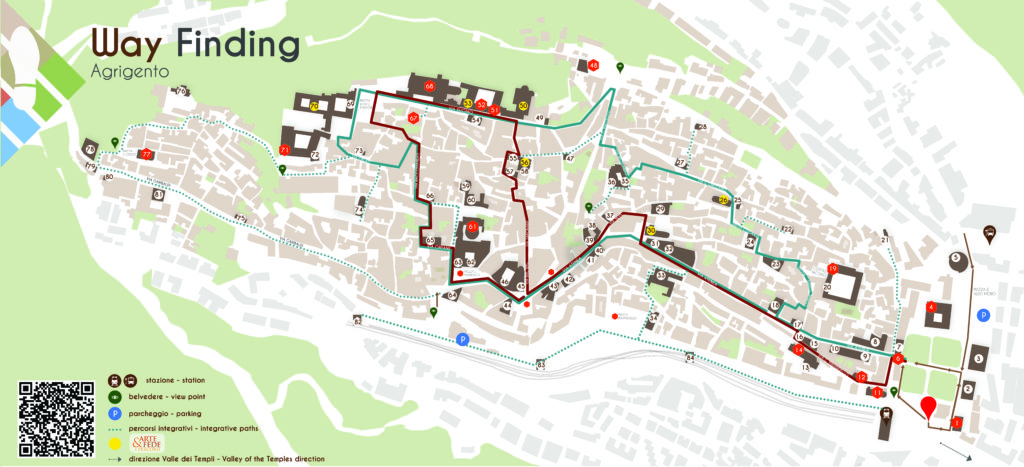Luigi Pirandello describes in various writings the historical center of Agrigento.
From:
RITORNO
After many years, returning to his sad country at the top of the hill, Paolo Marra realized that his father’s ruin must have begun just when he had built the house for himself, after having built so many for the others.
And he understood it by reviewing the house, no longer his, where he had lived as a boy for a short time,
in one of those old high streets, all slippery, which seemed like torrents that no longer flow: beds of pebbles.
VISTO CHE NON PIOVE …. (Tonache di Montelusa)
…, after the solemn functions in the church, was conducted on the fercolo in procession through the steep streets of Montelusa, among the old chapped houses, pressed, almost one on the other; up, up, up to the Cathedral at the top of the hill;
IL TURNO
Ah, if instead of being born in that sad dying town, he was born or raised in a living, bigger city, who knows! who knows! the passion he had for music would have opened a future for him. An unknown force in the soul felt it: the force that pulled him at certain moments to the old and forgetful spinet of his mother and moved his fingers on the keyboard to improvise by ear minuets and rondo. Some evenings, as he contemplated from the solitary avenue, at the exit of the village, the grandiose spectacle of the countryside below and of the sea at the end lit up by the moon, he felt taken by certain dreams, distressed by certain melancholies. In that country, a vanished city, Agrigento, a magnificent city, rich in marbles, splendid, and springs of skilful idols. Now the trees grew there, around the two ancient temples, the only survivors; and their mysterious rustling merged with the continuous bubbling of the sea at a distance and with an incessant quivering sound, which seemed to derive from the bland light of the moon in the abandoned quiet, and it was the song of crickets, in the midst of which plaintive, remote, of an owl.
IL VITALIZIO
It was not for nothing that the people of the town recalled it with pleasure to the ragged and dusty memory of the slippery wards of the San Michele district with the bale of merchandise on their shoulders and the half-moon in one hand, all sweaty while the other was spokesperson in shouting: – Roba di Fràaancia!
…
Instead of Porta di Ponte he preferred to take the via Solitaria under San Pietro to the Piano di Ravanusella; with everything that was so bad that way for so many crimes remained obscure and, to pass on late, it instilled a certain dismay. The steps echoed you, because the slope of the hill was too steep and almost there, behind the walls of the houses. Houses that, on the front, in the little street higher up, were of a single plane and of a miserable appearance, here behind they had certain walls that looked like a cathedral. On the other hand, in the beginning, the street still showed the ancient city walls with half-ruined towers. In the first one, barely closed by a faded and ramshackle part the unknown dead were exposed and brought to justice for their judgments. Crossing that stretch, Marabito really felt, in the silence and between the echo of the steps, as a suspicion that there was something, in that way, of mystery; and he could not wait to get to the Plan of Ravanusella, airy. But he breathed there for a while. He had to go there to go up to the Strait of Santa Lucia, which was also infamous and almost always deserted, to succeed in Porta Mazzara, where he took the Via del Ràbato.
…
Marabito did not love her, that little housewife; just as he did not like the city, to which it hardly ever rose from the countryside. Now, little by little, he began to recognize the narrow streets, but as from afar, to certain smells that made him stop, because the awakened memories of his childhood awakened him. You could see a little boy dragged by his mother’s hand and up and up all those slippery alleys, cobbled like beds of torrents and all in shadow, oppressed by the walls of houses always close, with that little sky that you could see in the narrow of them, to turn up their necks, which even then you could not see, dazzled eyes from the light that glared from the high gutters; until it reached the Piano di San Gerlando on top of the hill. But up there, all the city saw nothing but roofs: roofs stretched over many shelves, old roofs, of worn tiles, or new roofs, blood, or patched, which dripped here and there, some more and some less; a church dome with its bell-tower next to it and a few terraces on which they blasted in the wind, and the laundry hung out to dry in the sun.
LA CASA DEL GRANELLA
The view of the deserted dirt road, after which the high hill on which stands the city overflows in a very rigid slope on a wide valley, with that single lamp, whose flame flickered in fear from the dense darkness that rose from the valley, it was not certainly made to encourage a man of fantasy a little altered.
UNO, NESSUNO E CENTOMILA
One of the twisting alleys of the old Richieri during the day overwhelmed by the stench of the rotten garbage, I went to the Badia
I VECCHI E I GIOVANI
Dominata, on the top of the hill, from the ancient Norman cathedral, dedicated to San Gerlando, the Bishop’s Seminary, Girgenti was the city of priests and dead bells. From morning to night, the thirty churches with long and slow tolls woke up the cry and the invitation to prayer, spreading throughout an agonizing oppression




